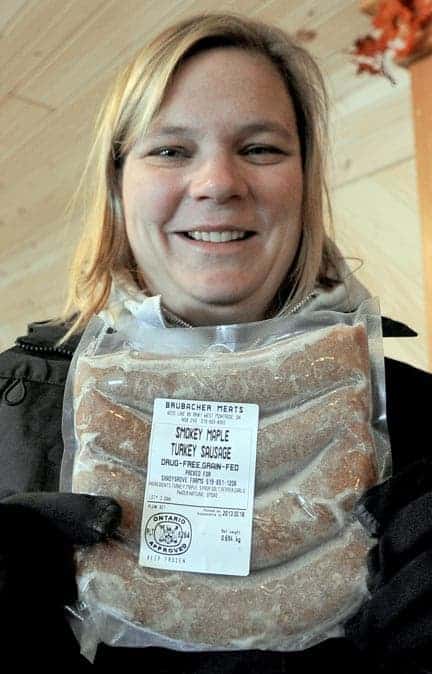It’s easier to tell the affluent from the poor in big cities: some neighbourhoods are better than others and the homeless more visible. Not so in rural areas such as Woolwich and Wellesley townships where most of the surroundings seem quaint and the residents prosperous, but there are those in need just the same.

Some 3,049 visits were made toWoolwich Community Services from the start of the 2012-2013 period to October 2013. The Wilmot Family Resource Centre had 2,262 visits from Wellesley and Wilmot residents in 2012, of which 1,089 were local children who make up nearly half of the population using food hampers in the region. Waterloo Region’s total hunger count for 2013 amounts to 28,213 people.
“People in the rural areas try to hide it because they want to fit in. If you are in the big city there’s places where you can go where there’s low-income people or you can go to a soup kitchen and everybody sort of dresses the same, but in the rural areas people just want to be like everyone else,” said Wilmot Family Resource Centre (WFRC) executive director Trisha Robinson.
Roxy Bellamy, a single mother of five from New Hamburg, came back to the WFRC after many years of making it on her own.
“When I came back a couple of months ago, I was actually crying because you don’t want to come back, but I had to,” she said.
Coming to the WFRC for the first time was agonizing for Marianne Irvine. She wants to raise awareness on how many people are finding it hard to survive on wages prevalent in today’s job market.
“I’d never accessed [social services] until this last year because of an illness that got totally out of control. I had to go on disability – it significantly reduces your income. In order to pay my rent and other living expenses I had to go to the food bank.
“I was very embarrassed and feeling shameful, I guess. Shameful that I didn’t have enough money to buy food for myself, but, having used the food bank here, that made me feel comfortable. You don’t feel worse and less of a person coming here,” Irvine said.
The people who get aid are a diverse tapestry of young, old, able and disabled residents who have fallen on hard times.
From April to October, WCS provided 128 food hampers to residents on disability pensions, 94 to single-parent households, the same number to two-parent families and 226 for singles. Meanwhile, 47 visits were made by rural residents with full-time employment who could not afford food in the same time period, a larger group than the 41 visits by part-time workers who used the same services.
The lack of public transportation in most rural areas contributes to the cost of rural living and medical treatment for low-income individuals, Robinson said.
A taxi cab to Grand River Hospital from Wilmot or Wellesley could cost up to $50 one way for someone like Irvine who must make frequent trips for treatment. She feels lucky to have friends and community members who help out.
“When you are living on disability and you have an illness and you’re trying to work around that and with that trying to earn income you just don’t have access to that kind of money. There’s no service available for people that are at the hospital and need to come home,” she said.
David Heimpel of New Hamburg and his wife weren’t always in need. They had a big house, a cottage in Muskoka … they know how fast it can all disappear. Twice they’ve had to turn to the WFRC.
“Initially when you go to a food bank you go ‘Huh? What am I doing here? I made good money, now I don’t anymore and I’m going to a food bank?’ The first time for my wife and I, we didn’t want to do it. You want to give not take – that’s why I support staff that’s here [at the WFRC],” he said.
Robinson added: “One day things seem good and the next day you’re having to use the food bank. I know some people don’t ever see a way out and to be on this side, I think it’s hard.”
Frank Spitzig, another client of Robinsons’, found himself looking for help after being laid off from a new job. He has a long history of stable, long-term work.
“I still feel like I have a lot to put out there, I know I do. I’m just not finished in the labour force yet but I’m not an employer’s dream; there are so many younger people out there that want jobs, need jobs, have families, and I’m single. I came here because it’s comforting and if I can help in any way, I’d be glad to.”
Local hunger stats are reflective of Food Banks Canada’s latest Hunger Count released in March. Though national numbers seem to be down – 833,098 people accessed a food bank that month – from 872,379 at the same time the previous year, use remains close to record levels, according to the organization and 23 per cent higher than in the beginning of the 2008 recession.
“Doesn’t matter where you’ve been or how good you think you have it, it can happen to anybody. Even a couple of million bucks in the bank, it doesn’t mean anything. I just want people to realize: don’t look down on us, we don’t want to be here,” Heimpel added.
While much of rural poverty is often hidden, the increasing need among children, couples and single adult residents in Woolwich and Wellesley has become apparent to those who know what to look for.
“Poverty is not a special holiday, it happens all year around,” said Elmira’s Joanne Kraemer.
Many years ago, when her husband Dennis was diagnosed with cancer, the couple turned to WCS.
Though the holidays are a designated time of giving, the need is present all year around. WCS’ hunger count of 1,691 visits in 2011/ 2012 rose to 1,987 in 2012/2013, and from April to October the organization already fed 1,062 first-time and returning food bank users.
Out of difficult straits and working as a grocery store cashier in Elmira, Kraemer has seen WCS’ director of community services Kelly Christie come into her store ever more frequently, buying food for those in need.
“I’ve watched Kelly have to shop more and more often for food.”
Kraemer is glad to see the organization moving to a larger facility at the southeast corner of Church Street and Memorial Avenue. It’s a move long overdue, Kraemer said, and one she hopes to support as a thank-you for the help she was once given.
“I was going to go to the store after New Year’s and buy this new table and chairs and then this letter came in the mail. I sat there and thought I don’t really need this new table, I just want it. I’m going to give this money to the campaign instead. [WCS] has been there for the community for 30 years. Dennis used to say: ‘If you don’t support the town, pretty soon it won’t be there.’ This is one of those times.”
If there’s one ballet that seemingly everyone in the world has seen, it’s The Nutcracker. From the inescapable Hans Christian Anderson music to the ubiquitous iconography to that Macaulay Culkin movie that pops up on TV every now and then, you might be forgiven for feeling a little Nutcrackered out this Christmas season.
Since The Nutcracker is arguably the most popular ballet of all time, the same weary feeling can been especially prevalent among dance companies.
“If you’re a ballet dancer, it’s part of your annual routine,” said Bengt Jörgen, artistic director of Ballet Jörgen, which tours annually with The Nutcracker. “It’s not considered a ‘serious’ work in many companies – they just put together some tutus and you’ve got the music, and it’s a little dismissive. In those cases, The Nutcracker can be just a chore to be gotten through with.”
For Ballet Jörgen, which returns to Kitchener’s Centre in the Square with its annual production on December 28, the secret to touring The Nutcracker year after year is to constantly keep the show fresh.
“I think that the key is to make it alive every year. You want to make sure that even if someone has seen the work and they come back, even if it’s the same work they see new things they haven’t seen before.”
He continued, “You have to assume that many of the people coming have seen it before; they want to see the same work, but they also want to be engaged and pleasantly surprised.”
Ballet Jörgen has responded to the challenge by making The Nutcracker central to the company’s identity – not merely a seasonal crowd-pleaser to boost the balance sheet.
“If it wasn’t such a strong Christmas work, it’s one that we could tour overseas,” said Jörgen. “It reflects well on the company, it reflects well on the Canadian identity. Because of that sense of artistic depth, it is a much more engaging and cohesive experience.
“We have made a specific decision to make sure The Nutcracker was a work we could perform at any time if there was an audience for it. If we went overseas to Japan, we could tour The Nutcracker in June because it’s a very artistically cohesive work.”
The biggest surprise in the production’s evolution came in 2008, when the setting was shifted to 1912 Canada, with enormous paintings by the Group of Seven used as backgrounds. “It’s still the same Nutcracker story,” noted Jörgen, “but now it’s a very unique production that reflects the Canadian identity.
“Even though it is the same work, you always have to update,” he continued. “It’s like a sports team that gets new players: you always have new dancers, and you try to get the right combination and you can do things a little differently depending on who the dancers are, and you can always improve every year.”
And yet, with a piece of entertainment as deeply familiar as The Nutcracker, in a holiday season where people savour their rituals, making changes while retaining the spirit must be a difficult balance.
“It’s completely a balance,” replied Jörgen. “You never change the context of the work – you just want to keep pushing the details. With any ballet, as the work grows you start seeing new opportunities, and as people get better at doing it, you can expand on certain parts and just make it more exciting.”
The Nutcracker, featuring Kitchener’s Michael Carvalho in the title role, will hit Centre in the Square on December 28 at 2 p.m. and 7 p.m. Tickets range from $42 to $77, and can be purchased at www.centre-square.com or by calling 1-800-265-8977.









